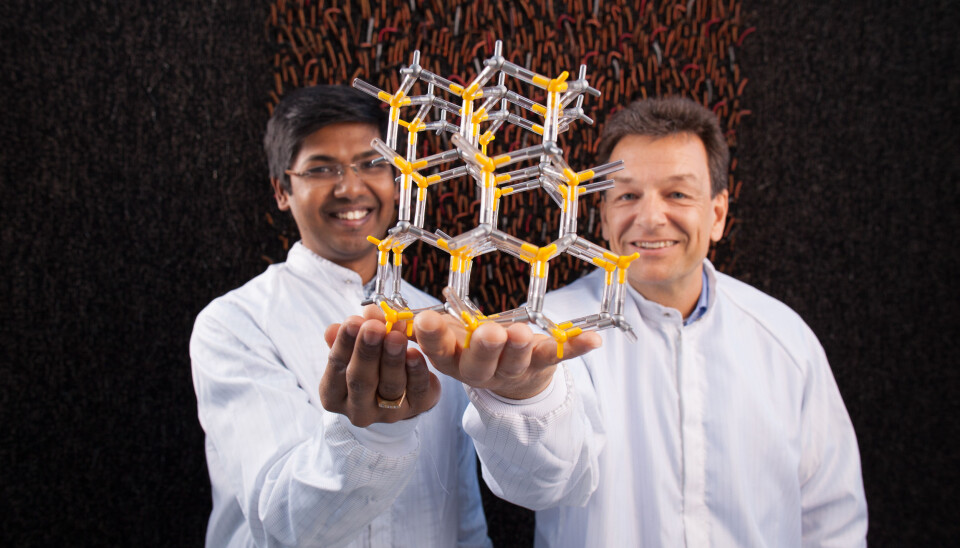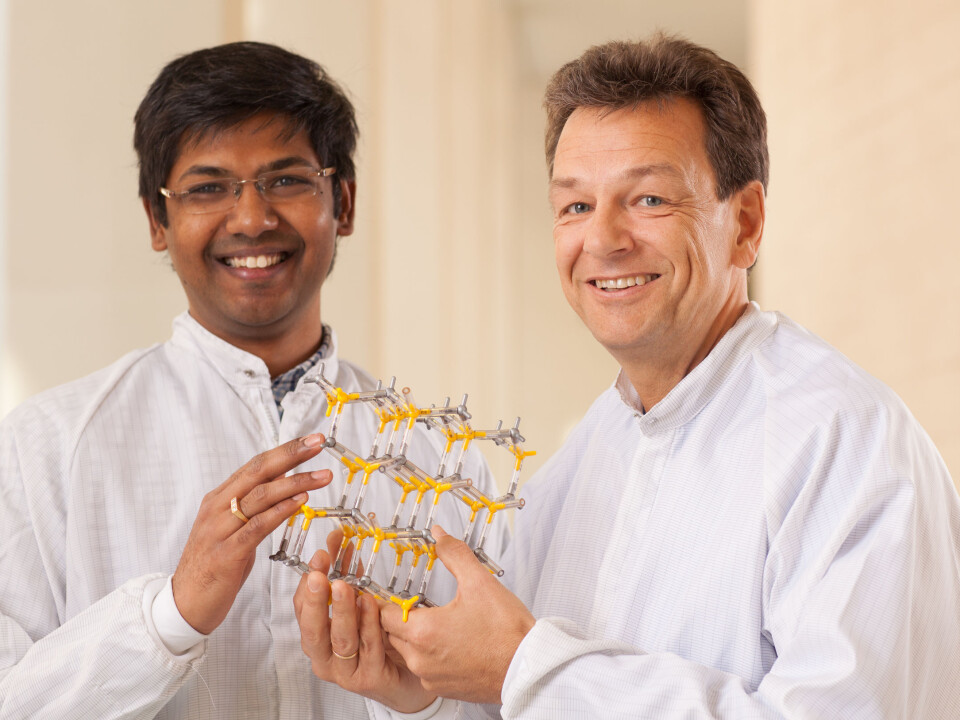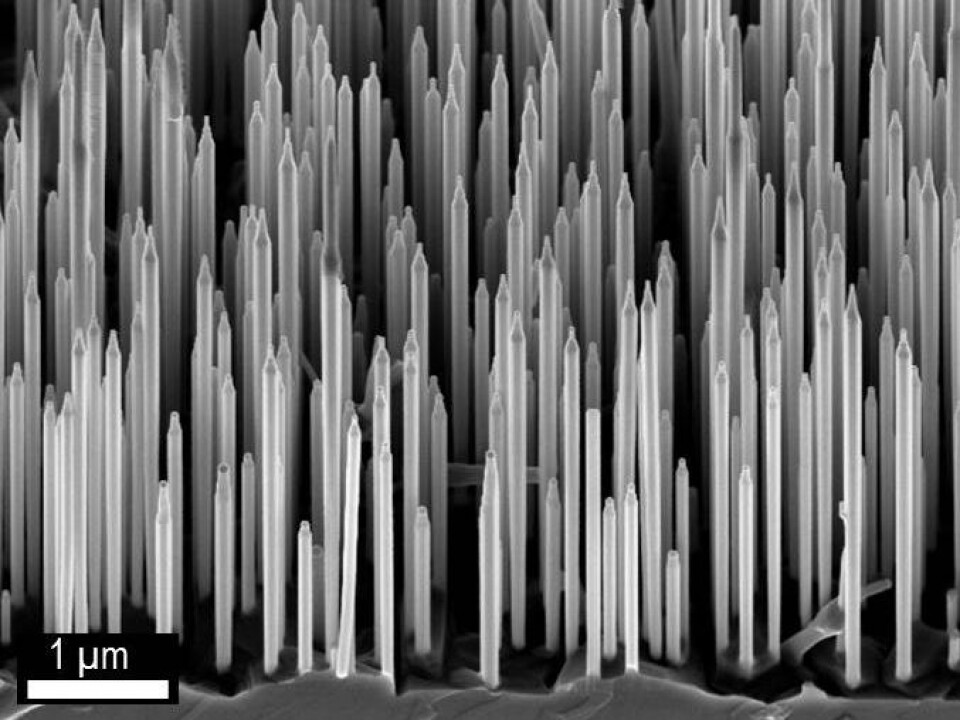An article from Norwegian SciTech News at NTNU

Nano-knowledge can lead to super solar cells
Atomic level changes in nanomaterials are contributing to incredible advances in solar cell and LED technology. Researchers have found a way to design nanowires with a built-in current that will make them even more effective in solar cells.
Denne artikkelen er over ti år gammel og kan inneholde utdatert informasjon.
NTNU researchers Dheeraj Dasa and Helge Weman have found that nanowires made of gallium arsenide can be used as either a light-emitting diode or a photodetector, with the help of a small electric current. A special hexagonal crystalline structure, called wurzite, makes this possible. The NTNU group, which conducted its studies with IBM Zurich Research Laboratory, has grown this material on graphene in the Molecular Beam Epitaxy (MBE) lab at the university.
The results were published in Nature Communications earlier this year.
The past few years have seen many big breakthroughs in nanowire and graphene research at NTNU. In 2010, Professors Helge Weman, Bjørn-Ove Fimland, and their group published their first groundbreaking discoveries in the field.
The researchers, who specialize in growing nanowires, have been able to control how the crystalline structure of a wire changes as it grows. They have found that changing the crystalline structure of a material, which means changing the placement of atoms in relation to each other, enables them to develop materials with new and unique properties. The NTNU group discovered how to change the structure of nanowires made of gallium arsenide and semiconductors.
A new type of solar cell

“We discovered that you can manipulate a structure one atom at a time. While growing nanowires, we were able to manipulate atoms to change the crystalline structure, which allows for incredible possibilities. We were among the first in the world to create a new type of material made of the same atoms as a different material, only in a different structure,” says Weman, a professor in the Department of Electronics and Telecommunications.
Nature does this all on its own. One example is graphite, which is found in your pencil, and is made up of the same carbon atoms as diamonds, but with a completely different structure.
And now, researchers are able to make changes to a material’s structure on an atomic level.
Graphene: a supermaterial
The next big discovery came in 2012 when the researchers were able to make semiconductor wires grow on sheets of graphene. Graphene is pure carbon, one atom thick, bonded together to form a honeycomb structure. It is the thinnest and strongest material ever created. Creating graphene was a revolution in the development of solar cells and LED components.

In the future, graphene may replace silicon as a component in electronic circuits. Today, silicon is used both in electronics and solar cells. Graphene is 100 times more conductive than silicon, and is only one atom thick, while a silicon wafer may be as much as a million times as thick. Graphene will likely be cheaper than silicon in just a few years.
The research group has gained international acclaim for their methods using graphene. Helge Weman and his fellow entrepreneurs Bjørn-Ove Fimland and Dong-Chul Kim have founded the company CrayoNano As, which works with a patented process to grow nanowires on graphene. The method is called molecular beam epitaxy (MBE), and the hybrid materials that are created have amazing electrical and optical properties.
“We’re showing how graphene can be used to create much more flexible and efficient electronics, starting with solar cells and white light emitting diodes (LEDs). In the future, we’ll look at more complex uses for our materials,” says Weman.
Effective solar cells
“The goal is to make solar cells that are more effective than the current thin film methods that are used,” he says.
Thin-film technology is used in solar cell technology to develop super thin solar cells where the active layer that converts sunlight in to energy is no thicker than three micrometers, or three-thousandths of a millimetre. The low weight of these solar cells makes them easy to transport, install and maintain.
Now, the combination of nanowires and graphene makes much more effective, more flexible solar cells possible.
In thin-film solar cells, the atoms are structured cubically, in a predefined structure. When researchers manipulate the atomic structure in a nanowire , they can grow both cubic and hexagonal crystal structures, which have different properties.
New discoveries, new possibilities
“Together with IBM, we have discovered that by stretching out a nanowire, we can create a light-emitting diode. And if we compress it, it makes an effective photodetector. The hexagonal crystalline structure known as wurzite allows this,” Weman said. “It makes it easy for us to change the structure, which means that its optical properties change when it is stretched or compressed, making it useful for many different things.”
“This also means that we have a much better understanding of how the material works, so we can make solar cells that are more effective by building in a small amount of stress on the wires,” Weman said.
“We can use this to develop new pressure sensors, or to collect electric energy when the wires are bent,” he said.
Because the researchers are able to manipulate the structure of these nano-wires, they can create highly effective solar cells. And the fact that CrayoNano is able to grow nano-wires on the super light, strong and very flexible material graphene means that they are able to produce extremely flexible, very light solar cells.
The CrayoNano group now plans to start growing gallium nitride nanowires that can be used in white LEDs.
“One of our goals is to be able to make gallium nitride nanowires in a recently installed MBE machine so that we can make LEDs with better optical properties, and grow them on graphene so that they are lightweight, flexible and strong,” Weman said.

































